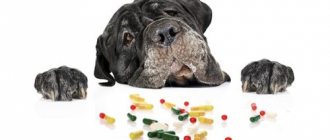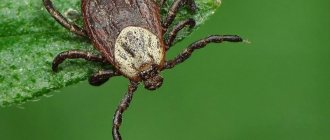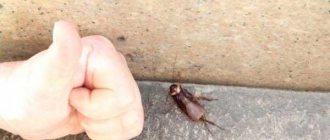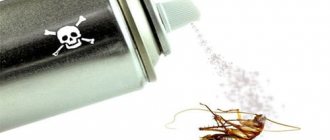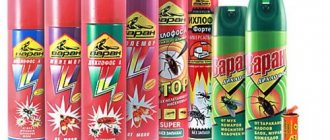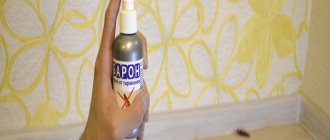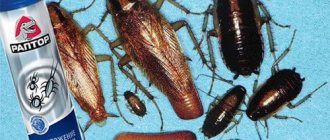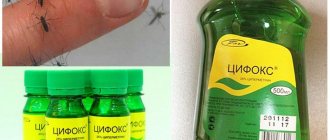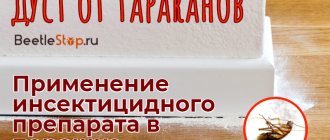How does dichlorvos act on cockroaches, how quickly does it kill them, do they all die from it, and how long does it last? Below are detailed answers to these questions.
In the last century, cockroaches were fought with dangerous poisons. Dichlorvos is one of these. It was synthesized by dehydrochlorination of chlorophos and produced until 1989.
But did you know that the cans with the inscription “Dichlorvos” that store shelves are crowded with today have nothing to do with that same dichlorvos? Their main difference from the original is the absence of a substance from the FOS group.
Let's consider whether the original drug helped get rid of cockroaches and how dichlorvos works on cockroaches now.
Does dichlorvos help against cockroaches - then and now
Classic Dichlorvos was an extremely smelly and toxic pest control agent. It consisted of an organophosphorus compound with the difficult-to-pronounce formula C₄H₇Cl₂O₄P (dimethyl dichlorovinyl phosphate), or DDVP for short.
Of all the highly toxic poisons, DDVF is the only one that could be “packaged” in aerosol form. The concentration of its vapors decreased to a minimum after 4 hours. This minimum met the old MPC standards, which made it possible to spray the product indoors. For example, dichlorvos was widely used to control flies. He also crushed cockroaches with a bang, even those that Karbofos could not cope with.
It is difficult to imagine a Soviet apartment in which dichlorvos was never used. Naturally, the systematic poisoning of cockroaches with this substance was not without negative effects: numerous poisonings among the population, increased resistance of cockroaches to organophosphorus chemistry. All this led to DDVF being removed from the list of approved insect control products in 1989.
But Dichlorvos was banned only as a substance, and not as a trade name . It has become too common to be used by manufacturers of household insecticides.
Today, only the name and authentic packaging remind us of the original dichlorvos. Obviously, marketers are using the famous brand, hoping to evoke consumer associations with the legendary insect repellent from the USSR.
What is included in the composition of modern “dichlorvos”?
Contraindications
However, there is a category of people who absolutely cannot use this drug, even if all safety points are observed. If the infected person is on the following list, then you should stop using Dichlorvos:
- Small children;
- people with respiratory diseases (asthma, asthmatic bronchitis);
- people with diseases or damage to the skin of the head and/or face (eczema, dermatitis, abrasions, scratches, bruises);
- women who are breastfeeding or pregnant;
- individual allergic reaction to this drug.
We recommend reading: how to safely and effectively get rid of lice during pregnancy.
The effect of dichlorvos on cockroaches from modern spray cans
99% of the so-called “dichlorvos” consist of synthetic pyrethroids that are safer for humans: ranging from permethrin and other low-toxic compounds, ending with cypermethrin, to which many populations of cockroaches have already developed resistance.
In order for the product to be allowed to be sold to the public, the manufacturer has to seek a compromise between effectiveness and harmlessness, because the aerosol significantly increases the hazard class of any insecticide, especially organophosphorus. It remains to either include the least toxic components in the composition, or significantly reduce their concentrations.
Today, insect repellent cans do not contain FOS insecticides, since their use in aerosol form increases the hazard class.
How does dichlorvos work on cockroaches?
Most products in aerosol packaging, including those labeled “dichlorvos,” have a short-term lethal effect on insects and are mainly aimed at repelling results. Cockroaches are more likely to be afraid of dichlorvos than to die from it. And, judging by consumer reviews, every year dichlorvos is less and less effective against them.
In addition, one cannot count on a residual effect. The chemical composition decomposes too quickly when exposed to sunlight, humidity and high temperatures.
Despite this, experience with use and individual reviews indicate that dichlorvos helps some people against cockroaches.
Alternative methods
Poisoning parasites with an aerosol insecticide is not the only “home” treatment option. Let's look at alternatives that have also been proven effective against lice:
- • Kerosene. Mix with shampoo and olive oil, apply to hair and lather well. The head is covered with a bag. After 60 minutes (for children - after 15 minutes), the composition is washed off, the hair is washed under warm water. Dead insects and nits are cleaned out with a comb. For greater effectiveness, the comb is soaked in vinegar.
- • Vinegar. Apple cider vinegar is added to water and the resulting solution is applied to the hair. To make the product more effective, after application, put a plastic bag on your head for 10-15 minutes. The final stage is thoroughly combing out the nits with a comb. The procedure is repeated until the nits are completely removed.
- • Essential oils. Parasites cannot stand the strong smell of essential oils of lavender, jasmine, coconut, anise, tea tree and eucalyptus. Moreover, the listed oils have an insecticidal effect on insects. Just add a few drops to olive oil, rub into the scalp and rinse after 30-40 minutes.
Be careful: methods based on kerosene and vinegar cause irritation of the scalp, which is especially pronounced in children. Hair also suffers, especially since the procedure must be performed regularly every three days until the parasites completely disappear.
Does dichlorvos kill cockroaches?
Under certain conditions, cockroaches die from dichlorvos. But whether it is possible to remove cockroaches with dichlorvos is another question. Now let's look at the mechanics of the process.
Aerosol chemistry affects Blattella germanica in three main ways:
- Penetration of DV through the chitinous membrane, resulting in paralysis of the nervous system
- Fumigation effect (through respiratory pores)
- Poisoning through the digestive system (contact with treated surfaces, poisoned food and water).
It is important to remember that the first two methods are activated only when the product comes into direct contact with the cockroach’s body!
With a successful combination of all factors, a cockroach that is “drunk on dichlorvos” dies on average in 15-20 minutes. The time of death varies from several minutes to several hours and even days. But in practice, most cockroaches come into contact with poison indirectly, receiving a non-lethal dose of poison. As a result, they run around poisoned for a long time until they finally die or the poison is removed from their body.
Dichlorvos can have a so-called “knockdown effect”: cockroaches fall “as if dead” within 30 seconds after forced contact with the poison. However, this is the end only for a small part of the individuals. The rest, having come to their senses, will run to drink water.
Interesting fact Experiments show that when there is a large concentration of cockroaches, the use of aerosol cans helps to achieve a more pronounced and lasting lethal effect. Conversely, the effect of dichlorvos on cockroaches at low numbers is ineffective, since aerosols do not have a prolonged effect.
It is also important to remember that dichlorvos does not affect cockroaches that are in the egg stage, because pyrethroids do not have an ovicidal effect.
Help with poisoning
When poisoning with Dichlorvos, it is very important to consider the route of entry of the insecticide into the human body and the severity of the damage. Let's look at the basic methods of first aid.
If a person affected by Dichlorvos is allergic, the first measure of help should be to take an antihistamine!
The presence of allergies is an indication for urgent use of an antihistamine
If the aerosol gets on the mucous membrane of the eyes, the first step is to rinse them with running cold water, a two percent solution of baking soda (1 teaspoon of soda is diluted in 250 ml of water) or saline. If your eyes are red, there is a burning sensation and tearing, you need to instill anti-inflammatory drops, apply a clean bandage and seek help from an ophthalmologist.
Eye drops will help eliminate the primary signs of damage to the mucous membrane of the eye
If the insecticide gets on your skin, you need to wash off the particles of the substance with cold water and soap or a soda solution (as described above). Under no circumstances should you rub the affected area, as if the skin is damaged, toxins can enter the body and cause more severe poisoning. A person who has been poisoned by Dichlorvos vapor must be taken out into clean air and changed into clean clothes, not saturated with a toxic substance. The mouth and nostrils should be rinsed with water. After these measures, the patient is provided with bed rest and rest.
You can clean the skin affected by the insecticide with soap and water or a solution of baking soda.
Getting the insecticide inside will require more serious measures:
- Provoking vomiting;
- Reception of sorbents;
- Use of laxatives;
- Drinking frequently and heavily.
Activated carbon is an excellent assistant in the fight against poisoning.
After drinking a large amount of liquid, the victim is artificially induced to vomit. Next, any sorbents are used (such as Sorbex, activated carbon and the like), and after an hour - saline laxatives (Carlsbad laxative salt, magnesium sulfate and others). If the person providing assistance has the appropriate skills, it is recommended to do a cleansing enema. The patient should remain in bed, adhere to a diet and take plenty of fluids (teas, jelly, kefir). If the victim’s condition does not improve or worsens, it is necessary to call an ambulance or transport the patient to the nearest medical center.
For children
If the insecticide is ingested, symptoms of poisoning begin to appear within a few minutes afterward. If the skin comes into contact with a chemical, signs of damage may develop within a few hours. It should be noted that due to weak, immature immunity, young children react to a toxic attack much faster and more intensely. If children under 1 year of age are poisoned with Dichlorvos, a visit to the doctor is mandatory!
If symptoms of poisoning appear in infants, you should immediately call an ambulance or go to the hospital
Signs of poisoning in a child may include:
- Lethargy;
- Apathy;
- Drowsiness;
- Anxiety;
- Nausea;
- Vomit;
- Heat;
- Skin rashes;
- Impaired coordination of movements;
- Cramps.
The best solution if signs of poisoning appear is to seek qualified medical help. While waiting for the ambulance to arrive, the baby should be kept hydrated by drinking water, tea or a glucose-saline solution of 5-10 ml every 5 minutes. Carefully monitor the child’s breathing, take care of a comfortable body position. If a child has inhaled chemical vapors, open the window to allow fresh air into the room; in the warm season, you can place the patient on the balcony or in the courtyard of the house. The child can be given children's sorbents (Smecta, Polyphepan, white coal and others). The dosage specified in the manufacturer's instructions must be strictly followed.
Pregnant
Dichlorvos poisoning during pregnancy is a threat to the health of the expectant mother and child. Just one inhalation of toxic fumes in the early stages can cause fetal death. Doctors do not recommend the use of such products throughout pregnancy. However, if trouble does occur, symptoms such as dizziness, nausea and loss of coordination will immediately indicate this. What to do? As in the case of poisoning in a child, the most correct option is to be examined by a doctor and follow his recommendations. While waiting for a meeting with a medical professional, drinking regimen is important - 1-2 sips of clean water or mineral water without gas, tea or fruit drink every 5 minutes. If your body temperature rises to more than 38.5 degrees, you can take paracetamol tablets. It is allowed to take sorbents whose instructions contain no contraindications for use during pregnancy.
If fever appears as one of the signs of poisoning, a pregnant woman can take one Paracetamol tablet
Animals
Our smaller brothers are also at risk of poisoning from insecticides, so while the premises are being treated, animals should be isolated or temporarily relocated to friends or relatives. If your pet is still poisoned, you can find out about it by:
- Numbness;
- Muscle trembling;
- Vomiting;
- Excessive secretion of saliva;
- Diarrhea;
- Difficulty breathing;
- Constricted pupils;
- Photophobia;
- Rare pulse;
- Tactile sensitivity;
- Cramps;
- Paralysis of limbs.
Hyperfunction of the salivary glands in animals is one of the symptoms of poisoning.
Providing assistance to an animal affected by Dichlorvos is not an easy task. Not everyone and not always have the opportunity to quickly get an appointment with a veterinarian, but you need to save your pet. What to do:
- Remove the injured animal to fresh air;
- Stop exposing your pet to the chemical;
- Clear the stomach by drinking plenty of fluids;
- Give sorbents;
- Take him to the vet.
If poisoning occurs due to contact of Dichlorvos with the skin and fur of an animal, it should be washed off with cold water. If affected by the insecticide through the gastrointestinal tract, you will need to induce vomiting. To do this, give the injured pet a large amount of water or saline solution (1 teaspoon of regular table salt per 500 ml of water). Taking into account the fact that the animal is unlikely to want to drink a lot, water or solution will need to be poured in forcibly, one spoon at a time.
To give an animal water or liquid medicine, you can use a medical syringe without a needle.
Weakness, apathy, reluctance to swallow and convulsions are contraindications to artificially inducing vomiting. After cleansing the stomach, it’s the turn of sorbents. You can use activated carbon at the rate of 1 tablet per 1 kg of pet’s weight. The crushed coal is mixed with water and poured into the mouth or mixed with the injured animal’s favorite treat.
The sorbent in powder form can be mixed with your pet’s favorite food.
I have had to deal with poisoning of pets. Despite the fact that the cause was not Dichlorvos, but another substance, drinking regimen and taking sorbents are general recommendations for providing assistance in case of any poisoning. I would like to note that pouring liquid into the mouth of a cat that was scratching and escaping from her hands was very problematic, so I had to swaddle her. Therefore, if such manipulations with a larger animal are necessary, it is better to act together, asking someone close to you for help.
How long does dichlorvos work against cockroaches?
The lethal effect of Dichlorvos is short-term, lasting on average from 2-3 to 24 hours, subject to full compliance with the instructions for use.
| Name of the product | Duration of lethal effect |
| Dichlorvos Neo | 2 – 3 hours |
| Varan "Dichlorvos" | Acute effect 2 – 3 hours, residual effect up to 10 days |
| Dichlorvos Universal | Acute effect 2 – 3 hours, residual effect up to 5-7 days |
Why doesn't dichlorvos kill cockroaches?
As we have already found out above, dichlorvos does not affect everyone equally. Some cockroaches will die immediately, others will flounder on their backs for another 12 hours, others will climb onto the ceiling and calmly sit there, and others will run to their neighbors through the ventilation.
The low efficiency of aerosol cans is explained by at least two factors:
- features of the form of the drug, namely the short-term action of the aerosol - droplets quickly settle and evaporate
- chemical composition - light pyrethroids are put into aerosol cans, which only “invigorate” the insects, and at the same time quickly disintegrate.
However, these are not all the reasons. Purely biological factors should also be included here. And in this regard, it makes absolutely no difference what product is used. Let's take a closer look at them.
Factors of biological ineffectiveness
Every animal on Earth, in the struggle for existence, is forced to overcome unfavorable environmental conditions. And cockroaches are no exception.
From the point of view of evolutionary biology, the driving factor in this struggle is natural selection, in which the most sensitive cockroaches to poison die faster than others. Consequently, they do not have time to produce offspring similar to themselves - i.e. which would remain vulnerable to chemicals. And they die out. With each extinction, their place in the population is taken by more and more tenacious individuals with fixed variability.
Red cockroaches are so adaptive that their survival after persecution is fixed at the genetic level. It can be expressed in different ways - irritability or resistance.
- Irritability is the increased sensitivity of a cockroach, expressed in avoiding contact with poison, and, as a result, not receiving a lethal dose. This ability is natural for any living organism, is physiologically determined and may not be inherited.
- Resistance is the increased resistance of a cockroach, or the ability to neutralize an insecticide and safely remove it from the body. It is determined only genetically.
Both of these reactions are inherited by different genes and are reflected in different parts of the chromosomes, depending on the insecticidal group.
How does this happen? Surviving individuals give birth to offspring - larvae, in whose DNA certain mutations have occurred. The mutated chromosome allows the cockroach to neutralize the effects of toxic substances. The next generation will certainly inherit this gene. Thus, “immunity” to poisons of one or another composition is fixed and passed on from generation to generation.
Dichlorvos acts primarily on physiologically weakened cockroaches, and achieves 100% mortality for them. Do other individuals die? Of course not, the most resistant of them will “get over the disease”, survive and give birth to offspring that inherit this trait.
T. V. Shapovalov, biologist
How does dichlorvos affect cockroaches?
Cockroaches are more active after dichlorvos because the nervous system activates the muscular system, causing spasms. But if the dosage is lethal, then it does not last long, until the first convulsions and complete paralysis.
Is dichlorvos effective?
You can use different drugs on the same population of cockroaches, getting the same result . Or you can treat different populations with one effective remedy, and all cockroaches will behave differently . We have already figured out what this depends on.
Now it is important to learn how to determine in practice what certain reactions indicate.
Signs of resistance
Let's say you bought a jar of conditional dichlorvos and sprayed it directly on cockroaches, but this led to zero results (0 dead individuals). What does it mean?
You are probably dealing with insect resistance, which is inherent at the genetic level and passed on from previous generations.
In principle, dichlorvos will not work on such cockroaches, no matter how many cylinders you spray or how much you increase the dosage. Their nervous system does not react to the poison in any way, because during the process of metabolism, harmful substances are quickly neutralized and eliminated from the body.
Signs of irritability
If after baiting you notice that insects are crawling away, moving from the just treated room to neighboring ones, this does not mean that your cockroaches have become too smart. They are simply characterized by the same irritability - increased physiological sensitivity.
Their random movement from one area to another, “sitting” on the ceiling, electric stove, refrigerator and other atypical places indicates only one thing: another treatment is required, and possibly with a different drug.
By the way, if you use dichlorvos against cockroaches ineptly (i.e. at the wrong time and in the wrong place), it will irritate them in any case - regardless of whether such irritability is genetically fixed or not.
General information
Dichlorvos today is fundamentally different from the one that people remember from the Soviet era. Actually, from that option, the manufacturers, using a publicity stunt, left only the name that everyone remembered.
Dichlorvos actively helps remove many insects, such as fleas, bedbugs, cockroaches, and lice. This article discusses the effectiveness of this drug against head lice and nits.
The current Dichlorvos bottle is filled with completely different, more advanced, sometimes flavored substances. But they are all a combination of synthetic (artificially created) insecticides and are considered harmless to humans.
conclusions
Disinfectors often encounter biological resistance of pests. In case of “irritability”, it is necessary to carry out complete disinsection of the building, and if there is a suspicion of resistance, then treat more than once, alternating drugs according to certain schemes.
Do you want to destroy cockroaches so that you immediately forget about the problem? Avoid aerosol products. Instead, use emulsion concentrates (according to the instructions). And remember that eliminating the outbreak locally is easier and cheaper than when cockroaches are everywhere and you need to carry out a complete pest control of the building.
If you have any questions or don’t know what to do, we recommend that you seek professional help from specialists.
